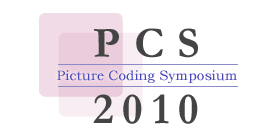Tutorial
Evolutive Video Coding -- From Generic Algorithm towards Content-Specific Algorithm --
Thursday, 9 December, 2010
Speaker: Dr. Seishi Takamura, NTT Corporation, Japan
Summary
Evolutive methods based on genetic programming (GP) enable dynamic algorithm generation, and have been successfully applied to many areas such as plant control, robot control, and stock market prediction. However, conventional image/video coding methods such as JPEG and H.264 all use fixed (non-dynamic) algorithms without exception. We have proposed a GP-based image predictor that is specifically evolved for each input image. It is a radical departure from conventional "fixed algorithm", "man-made algorithm" and "hand-made program" towards new paradigm such as "content-specific algorithm", "machine-generated algorithm/program". In this course, the predictor generation algorithm, its basic performance, application examples and some speeding up techniques of the evolution process will be presented.
Biography
Seishi Takamura received the B.E., M.E. and Ph.D. degrees in 1991, 1993 and 1996 respectively from Department of Electronic Engineering, Faculty of Engineering, The University of Tokyo. In 1996 he joined Nippon Telegraph and Telephone (NTT) Corporation, where he has been engaged in research on efficient video coding and ultra-high quality video coding. He is currently a senior research engineer, supervisor, Distinguished Technical Member at Video Coding Group of NTT Cyber Space Laboratories. His academic activity includes IEEE Trans. CSVT Associate Editor, IEEE Tokyo Section TPC Vice Chair, SID IDW DES Committee Member and IEICE Image Engineering SIG Secretary. From 2005 to 2006 he had been a Visiting Scientist at Stanford University, California. He is a recipient of 15 academic awards including ITE Niwa-Takayanagi Best Paper Award in 2002, IPSJ Nagao Special Researcher Award in 2006, PCSJ Frontier Awards in 2004 and 2008. Dr. Takamura is a member of MENSA, IPSJ, IIEEJ, ITE, IEICE and a senior member of IEEE.
Quality Assessment for Image Compression Purpose
Friday, 10 December, 2010
Speaker: Prof. Chaker Larabi, University of Poitiers, France
Summary
In the last years, image quality assessment became a very hot research topic especially for compression of image and video, first because of the large availability of multimedia applications and contents, and then because many scientists/engineers need to make a selection of algorithms and tools. This tutorial is designed to cover several aspects of the field of image quality assessment. After a brief introduction about the needs of quality assessment for multimedia applications, a review of the main approaches will be made by giving a description of the metrics categories and the subjective paradigms. At this point, it is important to distinguish between Full reference, reduced reference and no reference metrics but also understand the difference between image and video quality assessment. The focus of this course will be put on how to answer the question: which quality procedure for which application and which content? Another important topic for this course is on how to measure the performance of a given metric for a given application. Several practical examples will allow to better handle the quality assessment problem.
Biography
Chaker LARABI received his PhD from the University of Poitiers in 2002. He is currently associate Professor, in charge of the perception, color and quality activity at the same university. He is the president of French National Color Imaging Group (GFINC) founded in 2002. His actual scientific interests deal with image and video coding and optimization, and more specifically 2D and 3D image and video quality assessment. He works on the Human Visual System modeling (spatial, temporal and spatio‐temporal) for the enhancement of several tools such as compression, digital cinema, etc. He is also a member of the French National Body for the ISO JPEG committee since 2000 and chair of the Advanced Image Coding group. He serves as a member of divisions 1 and 8 of CIE, a member of IS&T and a senior member of IEEE.
